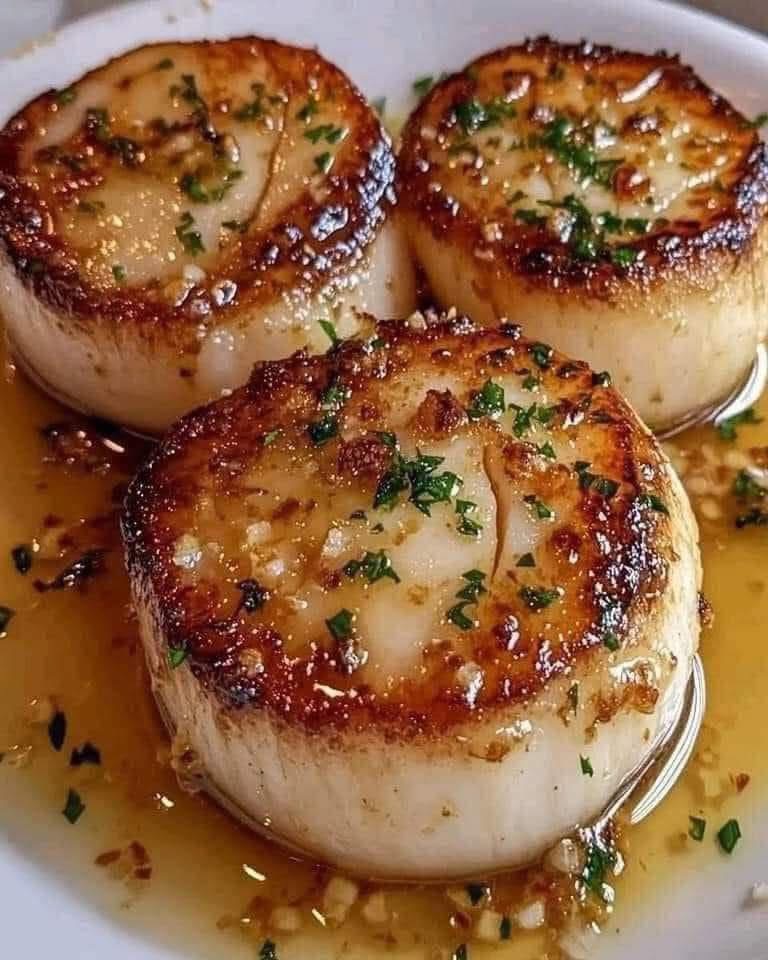Of course! Garlic Butter Seared Scallops are a restaurant-quality dish that’s surprisingly easy to master at home. The key is a hard sear for a caramelized crust while keeping the inside tender and sweet.
Here is a foolproof guide to perfect scallops every time.
Perfect Garlic Butter Seared Scallops
This recipe focuses on technique to ensure a beautiful crust and prevent rubbery scallops.
Yields: 2-3 servings as a main, 4 as an appetizer
Prep time: 10 minutes
Cook time: 6 minutes
Ingredients
· 1 pound (450g) fresh sea scallops, “dry-packed” if possible (see Pro Tips)
· 2 tablespoons unsalted butter, divided
· 1 tablespoon olive oil or avocado oil
· 3-4 cloves garlic, minced
· 2 tablespoons fresh parsley, finely chopped
· 1 tablespoon fresh lemon juice (about ½ lemon)
· Salt and freshly ground black pepper to taste
· Optional for sauce: 2 tablespoons dry white wine (like Sauvignon Blanc) or chicken broth.
Step-by-Step Instructions
Step 1: Prepare the Scallops (The Most Important Step)
- Pat Dry: This is the #1 rule. Place scallops on a stack of paper towels and pat them intensely dry. Remove all surface moisture. This is non-negotiable for a good sear.
- Remove Side Muscle: Check the side of each scallop for a small, tough tag of tissue (the “foot”). Pinch it and pull it off; it’s easily removed.
- Season: Season both sides of the scallops generously with salt and pepper.
Step 2: Sear the Scallops
- Heat the Pan: Place a large stainless steel or cast-iron skillet over medium-high heat. Let it get properly hot.
- Add Fat: Add the olive oil and 1 tablespoon of the butter. Swirl to coat the pan.
- Sear: Once the butter is melted and foaming, carefully add the scallops, one by one, making sure they aren’t touching each other. You may need to cook in batches to avoid overcrowding.
- DO NOT TOUCH THEM: Resist the urge to move them! Let them cook undisturbed for 1.5 – 2 minutes for standard-sized scallops. You will see the edges turning opaque and a beautiful golden-brown crust forming about halfway up the side.
Step 3: Flip and Finish
- Flip: Using tongs, gently flip each scallop. They should release easily from the pan if a crust has formed.
- Cook Second Side: Cook for another 1 – 1.5 minutes on the other side. They should feel firm to the touch but still slightly soft in the center (like the fleshy part of your palm when you press it). Do not overcook.
Step 4: Create the Garlic Butter Sauce
- Reduce Heat: Immediately transfer the cooked scallops to a warm plate.
- Sauté Aromatics: Reduce the heat to low. Add the remaining 1 tablespoon of butter and the minced garlic to the same pan. Sauté for 30-60 seconds until fragrant but not browned.
- Deglaze (Optional): If using wine or broth, pour it in now. Use a whisk to scrape up all the browned bits (the “fond”) from the bottom of the pan. Let it simmer for 1 minute until slightly reduced.
- Finish the Sauce: Turn off the heat. Stir in the fresh lemon juice and chopped parsley.
Step 5: Serve Immediately
· Return the scallops to the pan and toss them gently in the garlic butter sauce, or pour the sauce directly over the scallops on the plate.
· Serve immediately while hot.
Serving Suggestions
· Over Pasta: Toss with linguine or angel hair pasta for a luxurious meal.
· With Risotto: Serve on a bed of creamy Parmesan risotto.
· As an Appetizer: Plate them on a small bed of arugula or microgreens.
· With Crusty Bread: Essential for sopping up every last drop of that garlic butter sauce.
Pro Tips for Success
· Buy “Dry-Packed” Scallops: These are not treated with STP (sodium tripolyphosphate), which makes them retain water. “Wet-packed” scallops will steam instead of sear and will never achieve a good crust.
· Room Temperature: Take scallops out of the fridge 10-15 minutes before cooking to take the chill off.
· The Pan Must Be Hot: A hot pan is essential for the Maillard reaction (browning) to occur instantly, creating the crust.
· Don’t Overcook: Scallops cook very quickly. Overcooking is the main reason they become rubbery and tough. They continue to cook a bit after being removed from the pan (carryover cooking).
· Don’t Crowd the Pan: Adding too many scallops at once will cause the pan temperature to drop, leading to steaming and a pale, soggy exterior.
Enjoy your incredibly delicious, restaurant-worthy garlic butter seared scallops
